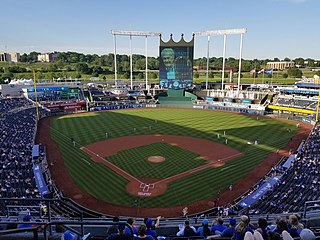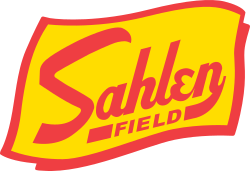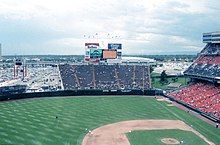
The Colorado Rockies are an American professional baseball team based in Denver. The Rockies compete in Major League Baseball (MLB) as a member club of the National League (NL) West Division. The team plays its home baseball games at Coors Field, which is located in the Lower Downtown area of Denver. The club is owned by the Monfort brothers and managed by Bud Black.

The Colorado Rapids are an American professional soccer club based in the Denver metropolitan area. The Rapids compete in Major League Soccer (MLS) as a member of the Western Conference. Founded in 1995, as part of the Anschutz Corporation, later to be a founding sports franchise of the global sports and entertainment concern AEG, the club is a founding member of MLS, playing their first season in 1996.

The Colorado Springs Sky Sox were a Minor League Baseball team in Colorado Springs, Colorado. The team played in the Pacific Coast League (PCL) and was the Triple-A affiliate of the major league Milwaukee Brewers (2015–2018), Colorado Rockies (1993–2014), and Cleveland Indians (1988–1992). The Sky Sox won the PCL title in 1992 and 1995.

Kauffman Stadium, often called "The K", is a baseball stadium located in Kansas City, Missouri. It is the ballpark to the Kansas City Royals of Major League Baseball (MLB). It is part of the Truman Sports Complex together with the adjacent Arrowhead Stadium, home of the Kansas City Chiefs of the National Football League (NFL). The stadium is named for Ewing Kauffman, the founder and first owner of the Royals. It opened in 1973 as Royals Stadium and was named for Kauffman twenty years later on July 2, 1993. Since its last major renovation in 2009, the listed seating capacity is 37,903.

Citizens Bank Park is a baseball stadium located in Philadelphia, Pennsylvania, in the city's South Philadelphia Sports Complex. It is the ballpark of Major League Baseball's Philadelphia Phillies. The stadium opened April 3, 2004, and hosted its first regular season baseball game on April 12 of the same year, with the Phillies losing to the Cincinnati Reds, 4–1. It is named after Citizens Financial Group.

Sahlen Field is a baseball park in Buffalo, New York, United States. Originally known as Pilot Field, the venue has since been named Downtown Ballpark, North AmeriCare Park, Dunn Tire Park, and Coca-Cola Field. Home to the Buffalo Bisons of the International League, it opened on April 14, 1988, and can seat up to 16,600 people, making it the highest-capacity Triple-A ballpark in the United States. It replaced the Bisons' former home, War Memorial Stadium, where the team played from 1979 to 1987.

Empower Field at Mile High is an American football stadium in Denver, Colorado, United States. Its primary tenant is the Denver Broncos of the National Football League (NFL). It opened in 2001 to replace the Broncos' original home, the old Mile High Stadium. The venue was previously home of the Denver Outlaws lacrosse team and the Colorado Rapids soccer team. It has also played host to countless concerts and served as the venue for Barack Obama's acceptance of the Democratic presidential nomination at the 2008 Democratic National Convention.

Coors Field is a baseball stadium in downtown Denver, Colorado. It is the ballpark of Major League Baseball's Colorado Rockies. Opened in 1995, the park is located in Denver's Lower Downtown neighborhood, two blocks from Union Station. The stadium has a capacity of 50,144 people for baseball.

Petco Park is a baseball stadium located in San Diego, California. The stadium is the home ballpark of the San Diego Padres of Major League Baseball (MLB). The ballpark is situated in downtown San Diego, adjacent to the city's Gaslamp Quarter. The largest stadium in San Diego, Petco Park hosts various community events, concerts, and sports throughout the year.

Cleveland Stadium, commonly known as Municipal Stadium, Lakefront Stadium or Cleveland Municipal Stadium, was a multi-purpose stadium located in Cleveland, Ohio. It was one of the early multi-purpose stadiums, built to accommodate both baseball and football. The stadium opened in 1931 and is best known as the long-time home of the Cleveland Indians of Major League Baseball (MLB), from 1932 to 1993, and the Cleveland Browns of the National Football League (NFL), from 1946 to 1995, in addition to hosting other teams, other sports, and concerts. The stadium was a four-time host of the Major League Baseball All-Star Game, one of the host venues of the 1948 and 1954 World Series, and the site of the original Dawg Pound, Red Right 88, and The Drive.

Kansas City Municipal Stadium was an American baseball and football stadium in the central United States, located in Kansas City, Missouri. It was located at the corner of Brooklyn Avenue and E. 22nd Street.

The Denver Zephyrs were a Minor League Baseball team based in Denver, Colorado, United States. They were a Triple-A team that played in the American Association from 1955 to 1962, the Pacific Coast League from 1963 to 1968, and the American Association again from 1969 to 1992. They played their home games at Mile High Stadium.

Hi Corbett Field is a baseball park in the southwestern United States, located in Tucson, Arizona. With a seating capacity of approximately 9,500, it was the spring training home of the Colorado Rockies and Cleveland Indians of Major League Baseball, and is currently home to the University of Arizona Wildcats of the Pac-12 Conference.
Robert Lee Howsam was an American professional sports executive and entrepreneur. In 1959, he played a key role in establishing two leagues—the American Football League, which succeeded and merged with the National Football League, and baseball's Continental League, which never played a game but forced expansion of Major League Baseball (MLB) from 16 to 20 teams in 1961–62. Howsam then became a prominent MLB executive as the highly successful general manager (GM) and club president of the Cincinnati Reds during the Big Red Machine dynasty between 1967 and 1977, when his team won four National League pennants and two World Series titles. He also served as GM of the St. Louis Cardinals from August 17, 1964, until January 22, 1967, where he inherited a team that would win the 1964 World Series, but made material contributions to the Redbirds' 1967 world champions and 1968 pennant-winners.
This is a list of sports in Denver, Colorado, United States. Denver is home to many professional sports teams who are based out of Denver and surrounding cities in the metropolitan area. It is also one of the twelve American cities to house a team from each of the U.S. cities with teams from four major league sports. All four of its teams play their home games near downtown with three active sports venues which includes Empower Field at Mile High, home of the Denver Broncos; Ball Arena, home of the Colorado Avalanche and Denver Nuggets; and Coors Field, home of the Colorado Rockies. There is also a Major League Soccer (MLS) team based in the Denver metro area, but they do not play their home games in the city of Denver and is located in nearby Commerce City.
Gerald H. Phipps was a businessman and sports executive. He was president of Gerald H. Phipps, Inc., a construction company and owner of the Denver Broncos American football club from 1961 to 1981.

Kelly James Burnham, known professionally as Alan Roach, is an American sports announcer and radio personality. He currently is the public address announcer for the Minnesota Vikings, Colorado Avalanche, and Colorado Rapids. Roach is also the official public address announcer of the Super Bowl, the voice of NFL events worldwide, and a public address announcer at 5 Olympic Games. He is one of the current voices of the underground train system in Denver International Airport. His announcing credits include 13 Super Bowls, 5 Olympic gold medal hockey games, and multiple All-Star games for the National Football League, National Hockey League, and Major League Baseball. He also serves as the announcer in EA Sports' since Madden NFL 21, as well as the FIFA series.
Jerry McMorris was the principal owner of the Colorado Rockies of the National League from 1992 through 2005.
DU Stadium, sometimes referred to as Hilltop Stadium, was a stadium in the western United States, located on the campus of the University of Denver in Denver, Colorado. Built 98 years ago in 1926, the crescent-shaped main grandstand design on the west sideline was based on other similar-sized stadiums from the same time period, Brown Stadium and Cornell's Schoellkopf Field, both in the Ivy League.


















